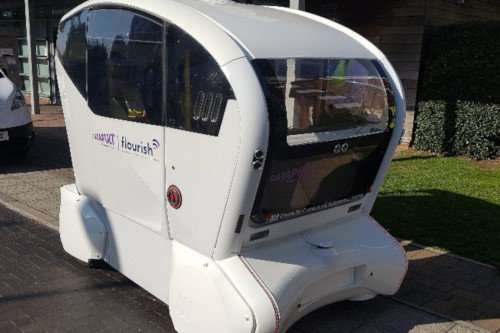Credit: FLOURISH
The West-of-England-based FLOURISH driverless car research and development project has today released its mid-project trials report detailing its latest findings and what they mean for the future deployment of connected and autonomous vehicles (CAVs) on the UK road network.
The University of Bristol's Professor Robert Piechocki said: "We are on the cusp of the biggest revolution on our roads since the advent of the internal combustion engine. Connected and Automated Vehicles (CAV) promise to deliver safe, efficient, inclusive and environmentally responsible transportation services. However future smart vehicles will require smart infrastructure to fulfil all the promised potentials. Roadside sensing (via lidar, radar, video etc.) will enhance road safety; virtual and dynamic signage and regulations communicated wirelessly will orchestrate traffic flow and resolve contention at intersections. The Flourish project attempts to provide the first glimpse of that future."
Tracey Poole, FLOURISH Project Manager, said: "Our trials explore what older adults need to be able to interact with CAVs with confidence. At a technical level, FLOURISH supports this aspiration by investigating how data can be used to optimise regional transport networks and how to ensure secure communications between autonomous vehicles and the surrounding transport infrastructure."
The early findings from this user research suggest that older adults prefer to use an uncluttered and highly intuitive Human-Machine Interface (HMI) to interact with CAVs. The results also indicate that trial participants' trust in the CAV is optimised when they have the option of receiving journey management information from the vehicle in both an audio and visual form. These findings will help inform future HMI designs.
Furthermore, the project's investigations into the dependability of communications and message handling between autonomous vehicles and roadside assets have spanned signal coverage, reliability of transmission and cyber responsiveness.
Under the trial conditions, the maximum distance for the successful communication of messages was 472 metres, with some non-line-of-sight coverage achieved. Transmission reliability, measured in terms of the awareness horizon, showed a rapid drop-off in the delivery of reliable communications beyond 120 metres. 95% of all messages were received within 778 milliseconds. The data gathered has provided a benchmark against which the performance of a wide range of Vehicle-to-Everything (V2X) services can be evaluated.
The outcomes from these trials are expected to provide the basis for the development of a future communications architecture for CAVs.
Credit: University of Bristol
FLOURISH Trials
The members of the FLOURISH consortium have developed rigorous tests and trials designed to examine both the experience of older adults and the technical functionality of CAVs, with a focus on data and secure communications. The project conducts its user-focused trials using a simulator and a pod, building a comprehensive understanding of what is required to provide a mobility solution which is positively received by older adults.
Specially designed and simulated scenarios enable the monitoring and post-trial evaluation of participants' responses to a range of issues with a focus on HMI usability, evaluated using physiological, cognitive and attitudinal factors. The same scenarios are then replicated in the FLOURISH pod to validate the findings from the simulator trial in a real-world urban network setting.
The FLOURISH car trials are conducted in Bristol and South Gloucestershire. The first car trial tested a connected vehicle network and associated technologies in a complex urban environment. Vehicle-to-Infrastructure communications between the autonomous vehicle and roadside units were examined. The trial assessed message delivery, the distance over which messages can be successfully sent (depending on the local environment) and the time between the sending and receipt of messages. It also tested success against the performance level of the transceivers, to develop an understanding of the impact of the communication equipment's performance on the functionality of the communication service.
Legal and insurance
FLOURISH has also released its Legal and Insurance Report today, which supports the findings of the user-focused trials that easy interaction with the vehicle is key to building trust. The report focuses on cyber security and data protection and makes a number of recommendations to help improve trust in the technology, including creating a comprehensive data map so people can understand how and where their data is shared.
The Future for FLOURISH
Tracey concludes: "Future simulator and pod trials will focus on gaining further insights into what older adults need from CAVs, looking at additional HMI features, including voice recognition. Future car trials will build on the previous trials to further test the CAV communication network, cooperative services and associated technologies."
More information: To find out more about FLOURISH, see the project website: www.flourishmobility.com/about-flourish
Provided by University of Bristol
























